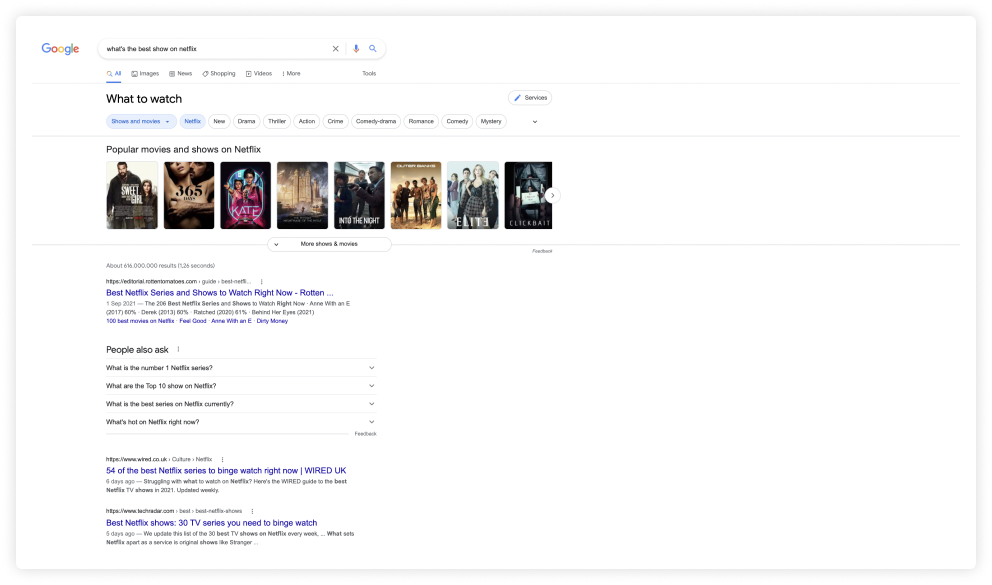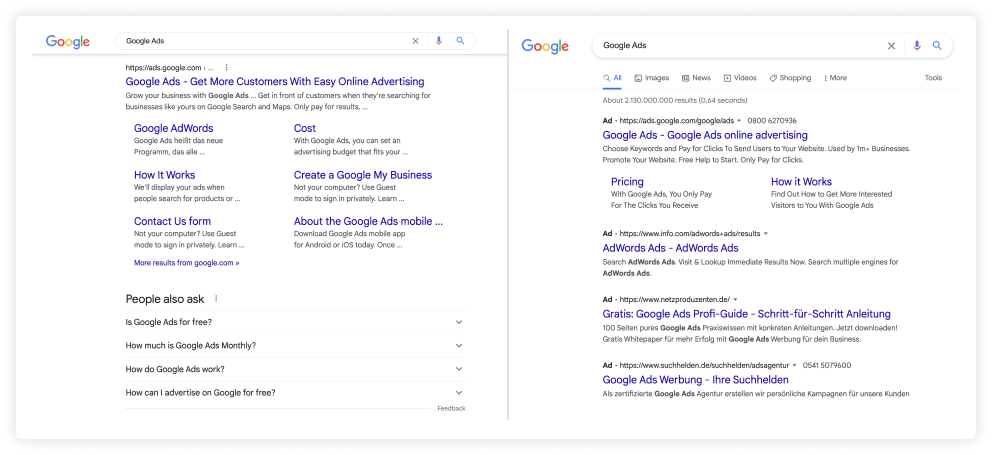Getting More Clicks with Competitor Analysis on The SERP
17 Sep, 2021

Every business owner is aware of their local competition. Whether it’s from chain stores or the bakery around the corner. Before marketing went digital, this competition was often the only competition that mattered.
But now that so many customers find businesses through Google’s Search Engine Results Page (SERP), competition can come from anywhere. This makes competitor and SERP analysis crucial skills that all businesses who want to find more customers online should have. This may seem daunting but it’s not as complicated as it sounds. Remember the SERP is just the page Google shows us after we type something in and hit enter. Here’s the SERP for the term ‘What’s the best show on Netflix?’

Paying closer attention to the SERP with competitor analysis will unlock best practice examples and new ways of thinking about marketing on the SERP that will boost your SEO and SEA activities.
Why SERP Competitor Analysis is Useful for SEO
We call them rankings on Google for a reason. After all, when we are talking about getting top rankings, who do we think is below us? Competition is built into the fundamental structure of how a search engine functions. It’s how Google is able to provide such relevant and useful answers.
Google always shows what it deems the best organic results (the results without ads) at the top of its results. This means that by analyzing the competition at the top of the SERP we can pick out common elements that we should include in our own content. This can be incredibly useful for all aspects of SEO and SEA from content to keyword choices. If you need some ideas for what is working, you can always go to the SERP.
Close analysis of competitors on the SERP is an incredibly useful tool for optimizing conversions in SEO and SEA. There’s a reason why we tend to click on certain results more than others, why some pages make it to the top and others don’t, and it’s not just to do with what is written on those pages at the end of those listings. A big part of it is to do with the way successful results are displayed in the SERP
Competitor SERP analysis is all about paying close attention to the way competitors’ results are displayed in the SERP to get insight into what’s working so you can integrate the best parts into your own best practices for SERP listings. Two key areas of focus in this type of competitor SERP analysis are keyword choices – the words competitors use to rank, and persuasive techniques– the way word choices and the structure of listings are used to make searchers more likely to click on a specific listing.
Competitor SERP Analysis for Google Ads
Competitor SERP analysis can also help you to improve your Google Ads. It’s important to remember that Google Ads get their top positioning because the site owner is paying a fee, not because their results are deemed to be the best results by Google, but since Ads are costing business money, any Ad that a company keeps running must be doing something right, or the site owner wouldn’t be paying the fee.
This is why tracking your competitor’s ads in the SERP is a great way of making sure you have all the best value terms targeted in your own ads. This will ensure you always have all the best values keywords for your industry covered so you can maximize the number of customers you get with your Google Ads budget.
SMB: rankingCoach FREE allows you to track your competitors informing you whenever they launch Google Ads featuring your keyword targets, so you can adjust your SEO and SEA strategies and stay ahead of them.
Get Free Competitor Monitoring Now
Competitor SERP Analysis for Improving SERP Listings
To get the best results with SEO and Google Ads you need to optimize your listings, but listing for the Organic results (SEO) and Google Ads (SEA) require different approaches. Competitor SERP analysis can be a great help in understanding the different approaches required different types of results in the SERP
To show you what I mean let’s take a look at some of Google’s own listings on its search engine. The one on left is organic results, and the one on the right is for a Google Ad.

Despite covering many similar areas the listings are very different in their approaches. The SEO listing is built around the type of questions a user might type into a search engine to find Google Ads: A user might type into Google how to get my business in front of customers searching for businesses like it on Google and in the top paragraph of the listing we see ‘Get in front of customers when they’re searching for businesses like yours'.
We also see terms linked to actions searchers mabe looking to complete such as ‘Download Google Ads mobile App'. This whole organic result is keyword-driven to make it likely to rank on Google for the terms customers are using. Using the words searchers are using is also a good way to draw their attention.
On the other hand, Google Ads SERP results feel much more salesy. Because the ads placement is secured by targeting and payment of a fee. The ad only needs to focus on converting the right searchers into clicks.
Due to this difference, Google Ads can be more persuasive and rely on many of the classic techniques used in marketing CTAs. This is why Google Ads often appeal more to customers’ desires, rather than mirroring their vocabulary, for instance ‘With Google Ads, You Only Pay For The Clicks You Receive’, note the use of all caps. We also have the persuasive use of figures in there too ‘Used by 1m+ Businesses’ consumers like facts and figures. This also draws the eye on the SERP.
What This Competitor SERP Analysis Means for Your Listings
This SERP competitor analysis shows that keywords need to play an integral role in your organic SERP listings. If you are targeting keywords that are often used by searchers in the form of that question. Try and get the question and/or answer into your SERP listing somewhere.
On the other hand, Google Ads needs to be more sales-driven. Make sure your ads are more convincing and appealing than your competitors, be sure to use eye-catching facts and figures, and appeal directly to searchers with the pronouns you. Capitalizing all the words in your titles can be a great way of making your listing stand out, just don’t overdo it.
Using the SERP Competitor Analysis to Avoid the Wrong Competitors
Search engines have completely altered the concept of competition. When we are talking about the competition on the SERP, we aren’t just talking about other businesses that sell the same products as you. We are talking about any results that stop our website from being chosen by a searcher who uses the keyword you are chasing.
Now everything is online, businesses are no longer just competing against one another. Without the right strategy, your business won’t just be falling behind its competitors, you may be wasting valuable time and resources to appear in places where customers are not even looking. If we are chasing the wrong keywords the site could appear in the wrong results. That is to say the searches of people who are not interested in buying your products.
This is another area where competitor analysis on the SERP can help. It can make sure your website is in all the best places where your competitors appear on the SERP, as well as helping you to find the valuable searches they don’t rank for. So you can secure a good spot for your business in the digital marketplace.
For all intents and purposes what can be found on a search engine is limitless, so are your keyword choices. Meaning if you get it wrong there is endless potential for creating needless competition. We can use the competitor SERP analysis to help us pick the right keyword battles.
A site selling products for dental hygiene won’t get many sales from outranking links to a video for the world’s largest electric toothbrush
Keywords need context and competitors provide that. It’s common sense that not everyone looking online for a Toothbrush is looking for one to buy, but we need to build this into our SEO strategy and the SERP can help.
Let’s say we are a US-based online dental product store looking to find the right keywords for our toothbrush product page. If I check the Google SERP for the most obvious choice ‘toothbrush’, I get the following results:
1) amazon.com/toothbrush/s?k=toothbrush
2) questions.universal-search-box.com/
3) getquip.com/
4) en.m.wikipedia.org/wiki/Toothbrush
5) nytimes.com/wirecutter/reviews/best-electric-toothbrush/
Only the first and third results are actually a page where the searcher can buy a Toothbrush.
The fact the other results are for searchers looking to do other things such as looking them up on Wikipedia or checking reviews (NYtimes), shows that searchers using this term have multiple intentions. Our business’s product page doesn’t want to compete for the attention of searchers who aren’t intending on buying a toothbrush.
This SERP tells the business owner that they need to add more words to their search phrase. This will eliminate competition from searchers who won’t lead straight to a sale. This is especially important for businesses running Google Ads in the SERP because every time someone with the wrong interest in your keyword clicks on your Google Ad that costs you money. Refining your keywords using SERP analysis can save you money and increase your conversion rates
Using the SERP Analysis to Refine Your Keywords
The SERP is also a great source of inspiration for longer keyword phrases. By adding more words to the term we start to remove the competition from results from searchers with different intentions. Adding additional words to target more specific searches is called building longtail keywords. Simply by adding ‘online’ to create the term ‘toothbrush online’ we remove the Wiki and review results and add in more sales pages to the top 5. This new term can then be tried as a better-targeted keyword because the top results show a closer link to our products and goal.
- getquip.com/
- amazon.com/Online-Best-Service®-Toothbrush-Individually/dp/B012PLJ458
- oralb.com/
- caretobeauty.com/us/toothbrushes/
- cvs.com/shop/personal-care/oral-care/toothbrushes
By adding more keywords to your terma and checking them in the SERP you may reduce the total number of searchers but you can also reduce the number of competitors. This will can make it easier to get from page rankings on Google that can be much more valuable to your business than a further back listing on a more competitive search result.
SMB TIP: Keyword tools like those found in rankingCoach can make this process quicker and more accurate, because for each term it tells you the competitiveness, its average monthly search volume, and suggests valuable long tails that your business can rank well for.
The Final Word On Competitor Analysis in The SERP
By paying a little closer attention to the SERP we can get some great ideas and a better idea of the kinds of descriptions we need to get top rankings. We reduce the time and money we waste by only targeting our marketing content at the right audience.
Get Free Competitor Monitoring Tools Now
